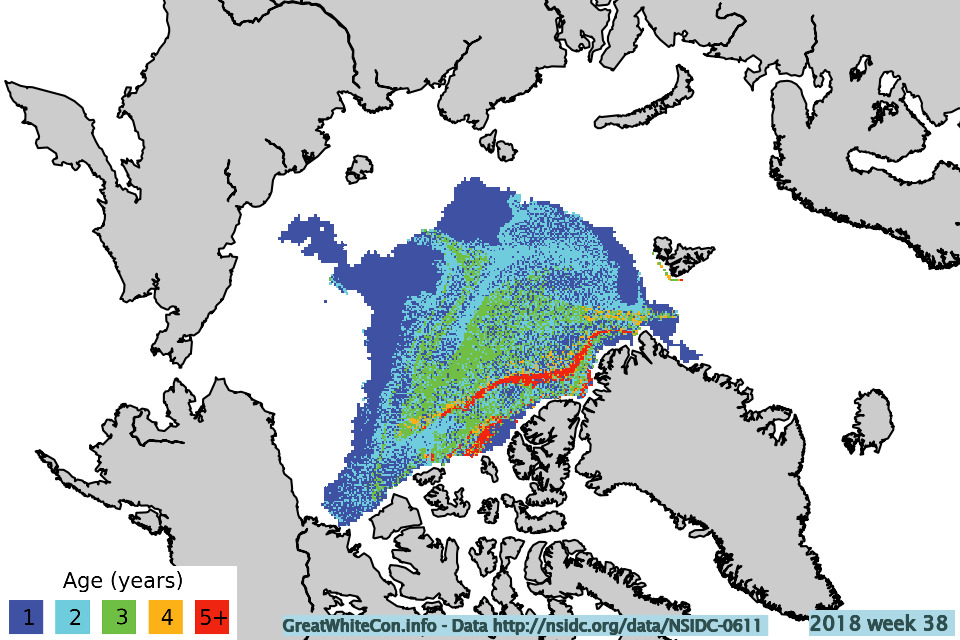Further to our recent coverage of the voyage of the good ship Polarstern past Kap Morris Jesup comes this video courtesy of Suman Singha:
An animation created with 2745 high resolution Sentinel-1 SAR images.
Sentinel-1 data courtesy Copernicus
Plus the early autumn estimates of Arctic sea ice thickness from CryoSat-2 via the Centre for Polar Observation and Monitoring:
Please note the abnormally thin sea ice to the north of Greenland.
Finally, for the moment at least, here’s the latest Arctic sea ice age information extracted from the October 2018 edition of the NSIDC’s Arctic Sea Ice News:
The “oldest, thickest sea ice in the Arctic” seems to be vanishing before our very eyes.



Via Mark Brandon on Twitter, a new open access paper from Ron Kwok on the topic of “Arctic sea ice thickness, volume, and multiyear ice coverage: losses and coupled variability (1958–2018)“:
Hi Jim,
(With the Facebook log-in down at Neven’s and not being a twitterer, I am unable to post there. So before I forget about it, I thought to put my take on Kwok (2018) on your G.W.C. site.)
The wording of Kwok (2018) is very strange, perhaps suggesting a second-language situation. My take on his comments (about the decline being “more moderate” when MYI is disappeared) is not that FYI is more resilient but that the comment is not actually talking abut the September minimum. Rather it is talking about earlier in the melt season and later in the freeze season. As it will still be cold at these times, any ice will be more difficult to melt but it is only the FYI that will be present precisely because all/almost-all the MYI has been melted out.
Kwok does make one reference when discussing FYI (as he calls it – “seasonal ice”) saying “With the large decline in MYI coverage over this record, there is a reversal in the relative contributions of the two ice types to the total area of the Arctic Ocean ice cover. Seasonal ice, having surpassed that of MYI in winter area coverage is now the dominant ice type, shifting the Arctic ice cover into a new normal where the focus on understanding processes over first-year sea are as important as those over MYI ice (Jeffries et al 2013).”
And Jeffries et al (URL below) is discussing a much-melted Arctic, not one stuffed full of FYI.
http://www.homepages.ed.ac.uk/shs/Climatechange/Arctic%20ice/Jeffries%20Overland%20Arctic%20new%20normal%23.pdf
Hello, good morning (UTC) and welcome Al,
Unless I’ve completely misunderstood (which is entirely possible!), I think you’ll find that Ron’s first language is US English with a bit of an accent:
As per my comment over at Neven’s, have you had a look at Chris Reynold’s “Slow Transition” thread over on the Arctic Sea Ice Forum?
https://forum.arctic-sea-ice.net/index.php/topic,933.0.html
P.S. The YouTube thumbnail reveals that Ron must be a big fan of “Snow White”!
https://greatWhiteCon.info/2015/02/shock-historical-news-towing-in-at-the-north-pole-in-1958/
Saltier water has encroached in that area of thin sea ice north of Greenland. The situation is quite dire. In the popular discussion the “hiatus” in sea ice extent loss since 2012 has overshadowed the influx of warm salty water into the Barents and Chukchi seas and the loss of multi-year sea ice. But the decline of Arctic sea ice is continuing in the dark season months when few people are paying attention.